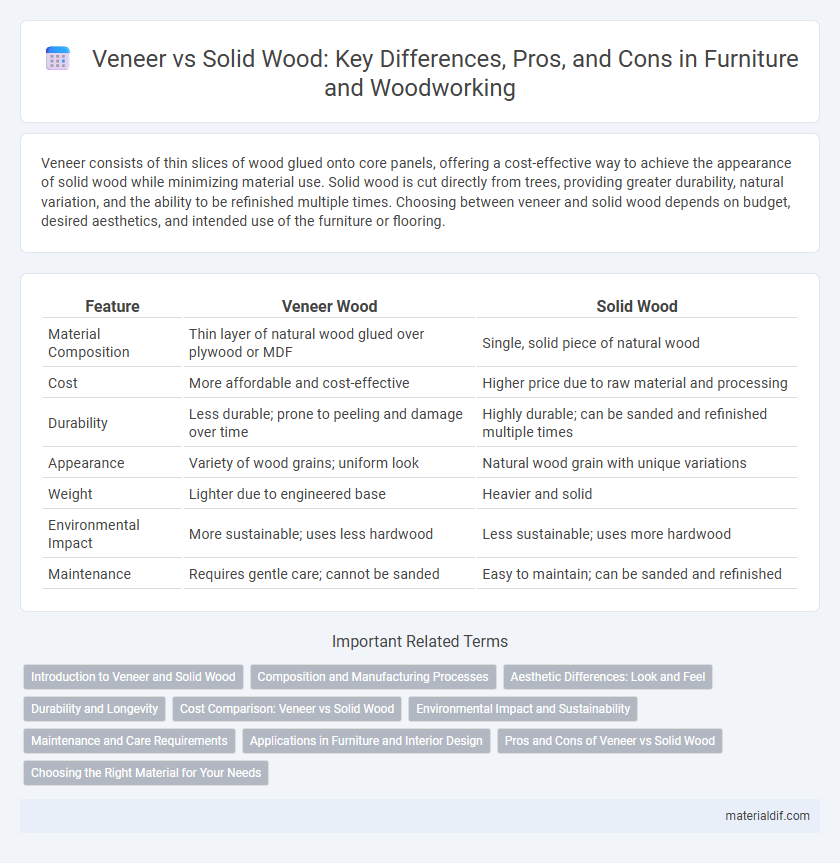Veneer consists of thin slices of wood glued onto core panels, offering a cost-effective way to achieve the appearance of solid wood while minimizing material use. Solid wood is cut directly from trees, providing greater durability, natural variation, and the ability to be refinished multiple times. Choosing between veneer and solid wood depends on budget, desired aesthetics, and intended use of the furniture or flooring.
Table of Comparison
| Feature | Veneer Wood | Solid Wood |
|---|---|---|
| Material Composition | Thin layer of natural wood glued over plywood or MDF | Single, solid piece of natural wood |
| Cost | More affordable and cost-effective | Higher price due to raw material and processing |
| Durability | Less durable; prone to peeling and damage over time | Highly durable; can be sanded and refinished multiple times |
| Appearance | Variety of wood grains; uniform look | Natural wood grain with unique variations |
| Weight | Lighter due to engineered base | Heavier and solid |
| Environmental Impact | More sustainable; uses less hardwood | Less sustainable; uses more hardwood |
| Maintenance | Requires gentle care; cannot be sanded | Easy to maintain; can be sanded and refinished |
Introduction to Veneer and Solid Wood
Veneer consists of thin layers of wood glued onto a core material, offering the appearance of solid wood with greater stability and cost-effectiveness. Solid wood is harvested from a single piece of timber, known for its durability, natural grain patterns, and ability to be refinished multiple times. Choosing between veneer and solid wood depends on factors like budget, application, and desired aesthetics.
Composition and Manufacturing Processes
Veneer consists of thin layers of wood sliced from logs and glued onto a core material such as plywood or MDF, optimizing material use and reducing waste. Solid wood is a single piece cut directly from a tree, retaining its natural grain and strength but requiring more resources. Manufacturing veneer involves precise slicing or peeling, while solid wood is shaped through cutting and drying processes to prevent warping.
Aesthetic Differences: Look and Feel
Veneer offers a consistent and smooth surface with intricate grain patterns that are often replicated from rare or expensive wood species, enhancing the visual appeal without the cost of solid wood. Solid wood showcases natural variability in grain, color, and texture, creating a unique and authentic look that changes over time with natural aging and wear. The tactile experience of solid wood is richer and warmer, providing a more organic feel compared to the often smoother but less textured veneer surfaces.
Durability and Longevity
Solid wood exhibits superior durability and longevity due to its dense, natural composition, resisting wear and damage over decades. Veneer, made by layering thin slices of wood over composite materials, offers aesthetic appeal but is prone to chipping and warping, reducing its lifespan. For long-term investment in furniture or flooring, solid wood outperforms veneer in maintaining structural integrity and enduring heavy use.
Cost Comparison: Veneer vs Solid Wood
Veneer offers a more cost-effective alternative to solid wood, as it uses thin slices of high-quality wood glued over less expensive substrates, reducing material expenses while maintaining an attractive appearance. Solid wood furniture commands higher prices due to the use of entire lumber pieces, which require more resources and craftsmanship for durability and longevity. While veneer provides budget-friendly options with efficient material usage, solid wood retains value for its strength and timeless appeal despite increased initial costs.
Environmental Impact and Sustainability
Veneer production utilizes thin slices of wood, significantly reducing raw material consumption compared to solid wood, which requires entire logs. Solid wood harvesting often leads to deforestation and habitat loss, whereas veneers maximize lumber efficiency and promote sustainable forestry practices. Choosing veneer helps lower carbon footprint by extending the utility of each tree, supporting responsible resource management.
Maintenance and Care Requirements
Veneer requires less maintenance than solid wood, as its thin surface layer is sealed to resist stains and scratches but can be damaged by excessive moisture or heat. Solid wood demands regular care, including polishing and treatment with wood oils or waxes to prevent drying, cracking, and warping over time. Both materials benefit from avoiding direct sunlight and maintaining stable humidity levels to prolong their durability and appearance.
Applications in Furniture and Interior Design
Veneer provides a cost-effective option for furniture and interior design with its thin slices of high-quality wood glued onto core panels, allowing for intricate patterns and consistent finishes. Solid wood offers superior durability and longevity, making it ideal for structural elements like table legs and cabinetry where strength is critical. Both materials are chosen based on application needs: veneer excels in aesthetic versatility and material efficiency, while solid wood is preferred for its natural grain, robustness, and capability to be refinished multiple times.
Pros and Cons of Veneer vs Solid Wood
Veneer offers a cost-effective alternative to solid wood by using thin slices of wood glued over a substrate, providing a consistent appearance and reducing material waste. Solid wood boasts superior durability, natural variation, and can be refinished multiple times, but it is more expensive and prone to warping in changing humidity. Veneer furniture may delaminate or chip over time, whereas solid wood resists damage and ages gracefully with proper care.
Choosing the Right Material for Your Needs
Veneer offers an affordable and sustainable alternative to solid wood by using thin slices of high-quality wood bonded to a core material, providing the appearance of solid wood with increased stability and resistance to warping. Solid wood, prized for its durability and natural beauty, is ideal for furniture requiring long-term strength and can be refinished multiple times to maintain its look. Selecting the right material depends on budget, intended use, and environmental factors, with veneer suited for decorative pieces and solid wood preferred for heirloom-quality furniture.
Veneer vs Solid Wood Infographic

 materialdif.com
materialdif.com